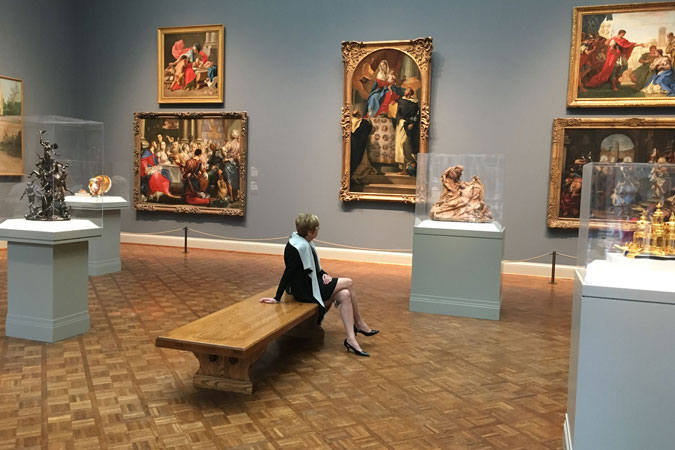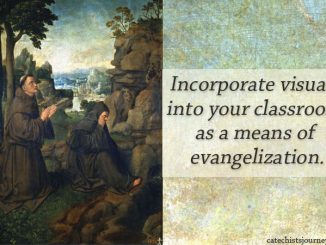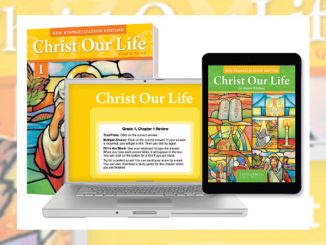
This is a picture I took several years ago of my wife, Joanne, pausing to sit and reflect at the Art Institute of Chicago. This is generally what we do when we encounter art: we pause and let it “speak” to us. Art that relies on images, shapes, and objects speaks to us without using words to tell a story.
I remember as a young child attending the Latin Mass and not understanding most of it. To pass the time, I would look around the church building at St. Casimir Parish (now Our Lady of Tepeyac) in Chicago. I’d look at the statues and paintings but particularly at the huge stained glass windows, which depicted stories of the Old and New Testaments. Without speaking a word, those “walls” taught me.
There’s an old phrase that says, “If these walls could talk…,” a phrase that is used when we describe a place where much has occurred without our presence. When it comes to Catholic churches (as well as other Catholic buildings), our walls—awash with sacred images—do talk! We are a sacramental people, which means that we encounter and express the mystery of God in ways that transcend words. I call this a language of mystery—a language that God used to reveal his presence to his people throughout Scripture: a burning bush, a mighty wind, a tiny whispering sound, a pillar of fire, a cloud of smoke, tongues of fire, and so on.
As Catholics, we use this language that relies on silence, images, movement, gesture, signs and symbols, music and song, and even smells (incense). Without a language of mystery, we remain incapable of truly encountering and expressing the mystery of God.
One of my favorite things, when it comes to the Finding God curriculum that I helped to develop for Loyola Press, is the inclusion of a language of mystery throughout the program. Finding God continually prompts catechists to integrate silence, music, sign, and symbol in its engaging sessions. Of all the elements of a language of mystery included in Finding God, none surpass the preeminence of sacred art. Throughout Finding God, young people encounter images of sacred art.
- The pages of the children’s book in Finding God are embellished with rich and beautiful images of sacred art: paintings (traditional and contemporary), icons, sculptures, and mosaics. View sample pages.
- The Finding God Catechist Guides often invite children to draw pictures rather than always relying on words to express themselves, thus engaging those whose strength is visual/spatial rather than linguistic.
- The Finding God Art Easels provide catechists and teachers with new methods to help children explore Scripture, Tradition, and concepts of the Catholic faith. With 25 different prints per easel, per grade, the Art Prints provide background about the artist and history and also offer activities related to the art, including art projects, music, movement, and imaginative prayer.
The most profound moments in life often transcend words. Encountering God is a profound experience. In order for faith formation to lead young people to truly encounter the mystery of God in their midst, a language of mystery must be relied on—as is found in Finding God. To learn more about the Finding God program, contact your Loyola Press Educational Consultant.





What a beautiful message today. I too love to reflect on a drawing or a painting of the Lord especially an old
and antique painting which reveals so much. We do this as a group at our weekly bible study class at church.
Thank you for your daily and insightful thoughts.
You’re very welcome, Patricia!